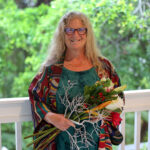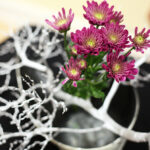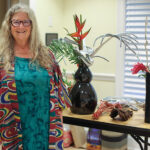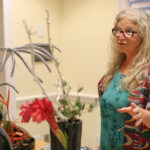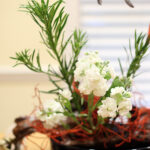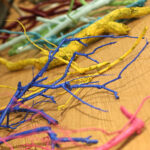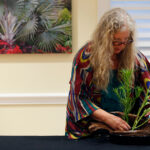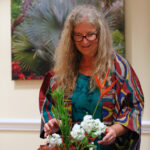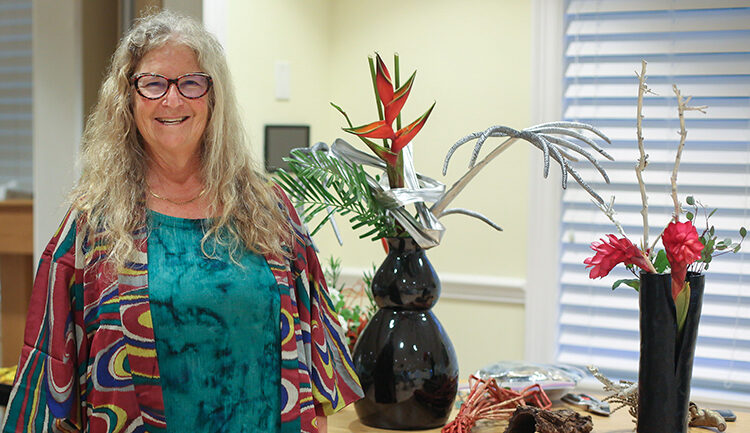
As Elaine Sigler’s husband tells it, she met the other love of her life in 2002, when she discovered Ikebana, the ancient Japanese art of flower arranging, at an exhibit at the Japanese Embassy in Ottawa, Canada.
Splitting time between Canada and Sea Oaks in Vero Beach, Sigler has since studied and worked passionately on the various levels of this spiritual floral art that dates to the seventh century, has its roots in Zen Buddhism, and was originally practiced by Japanese warrior samurai.
Ikebana is a philosophical, Zen-like way of arranging flowers, with the objective to make flowers “come alive” with materials that are living, but not permanent. As the flower opens, each stage shows a different beauty.
Of more than 3,000 different schools of Ikebana in the world (most in Japan), the two most popular in the West are the Ohara and Sōgetsu schools.
Sigler says she gravitated to Sōgetsu, the most modern of the disciplines.
She explains that the basic design principles of Ikebana must be understood before you can put together a successful arrangement. While different schools have different ideas, there are some constant principles throughout them all, the first being the principle of nature. How the artist views nature is how the arrangement comes about in reality.
After being swept away by the beauty of Ikebana, Sigler discovered that this art form helped her to unwind after a busy day running her own company as a communications consultant, where she worked with not-for-profit and government clients. Now retired, she continues to practice Ikebana because of the joy and focus it provides.
“At first I broke a lot of branches,” Sigler admits. But over time, with patience and a better understanding of the materials, she says her stress would melt away as she concentrated on the creation at hand.
Ikebana’s three main elements – lines, volume (used to add depth and weight to an arrangement) and focal point – are consistent in all the various schools. In addition, Ikebana makes use of positive and negative space, the relationship between the physical elements of the arrangement, and the empty space in the gaps of physical elements.
To a novice, it is somewhat like flower arranging on steroids – not in the size of the arrangements, though they can be quite large if outdoors, but in the fabric of the artform, that weaves and interweaves the numerous and strict curriculum and principles, and brings in a spiritual aspect to the craft.
In 1927, Sofu Teshigahara founded the Sōgetsu School, becoming its first lemoto. He felt that flowers become human in Ikebana, that the heart of a person who arranges in Ikebana is reflected directly in that work, and Ikebana becomes that person. He also believed that from the moment you choose to express something with a piece of flower in your hand, a world of your own creation begins.
Akane Teshigahara, the current and fourth lemoto (a title often inherited or a designated role within the founder’s family), is the granddaughter of Sofu, and the daughter of Sofu’s son, Hiroshi, who was the third lemoto. The second lemoto was Sofu’s daughter.
Akane Teshigahara adds that Sōgetsu Ikebana’s popularity draws out the freedom of expression in each individual, always new, always beautiful, and never constrained by preconception.
After studying the specific levels of this art form, it took seven years for Sigler to qualify for a teacher. With eight levels of teaching certification, she has attained the Teacher Diploma 2nd Grade Jonin Sanyo, and recently submitted her credentials for 1st Grade Somu.
Sigler’s title of Sensi (teacher) and a Japanese name of Seiki was conferred on her by the Sōgetsu School of Ikebana at their Foundation Headquarters, in Akasaka, Minato-ku, Tokyo, where the basic skills are taught, celebrated and exhibited.
She says she is constantly learning new techniques and experimenting with different materials, finding that Vero’s sub-tropical climate has introduced a wonderful new set of challenges.
Her work has been exhibited at both the National Art Gallery and the Museum of Nature in the U.S., at the Embassy of Japan in Ottawa, Canada’s Museum of Nature, and the National Gallery of Canada.
As a participant in the Art in Bloom exhibition at the Vero Beach Museum of Art since 2013, she won Best Use of Texture for her interpretation of the Charles Burchfield painting this year, the Best Use of Texture for her interpretation of a Judith Leiber bag in 2019, and the Curator’s Choice Award for an arrangement depicting a John Marin painting in 2017.
“When you hear a symphony orchestra, see a dance or a painting, they evoke an emotion,” says Sigler. Similarly, as in the Art in Bloom interpretations, she says, “it makes you see beyond the painting.”
The actual materials used in an arrangement are generally just two or three plant varieties and can include live and dried plant material, as well as non-traditional objects such as ribbon, recycled water bottles, metal wires, cellophane, even the odd hubcap.
The branch material – anything from holly to bamboo branches – often emphasizes the simplicity of the materials; a line of a branch, the color of a single flower, or a new bud, and its contrast with the container.
She adds that occasionally paint is used in an arrangement.
“A black vine can be striking, and a silver painted leaf may make a more elegant arrangement,” says Sigler, who will also incorporate interesting materials she finds, such as a Kiwi Vine, or a dried leaf from a Staghorn Fern or a Bird of Paradise.
“It is really important to know where the arrangement will be placed and how it will fit into its surroundings.”
Sigler, who teaches classes in Vero Beach and Canada, continues to take classes herself to expand her knowledge of this esoteric art form. She says there is a contingent of Ikebanists in Melbourne, where she furthers her studies when in Florida.
Sigler’s dedication to Ikebana is more clearly appreciated when you learn of the regimented course work and study needed to move forward in this art form that takes years to develop, likening Ikebana to a journey.
“When you begin you learn the basics, the plant, and how to manipulate the materials. As you continue the process, you focus on line, color, mass and space, light and shadow, positive and negative space, as an integral part of an arrangement,” says Sigler.
“As you focus on the materials and their placement in the arrangement, all else melts away.
People really enjoy [Ikebana]; it is different than a Western style floral arrangement. It is a way of thinking, it’s a challenge to focus on creating an arrangement [using the raw materials at hand].”
Sigler says she feels a sense of accomplishment when her classes whet people’s appetites to explore the art form further.
And when she visits a friend for dinner, the requisite bottle of wine or box of chocolates is usually left at home. Instead, she brings an Ikebana arrangement.
“It introduces beauty into your home,” says Sigler.
Photos by Kaila Jones

